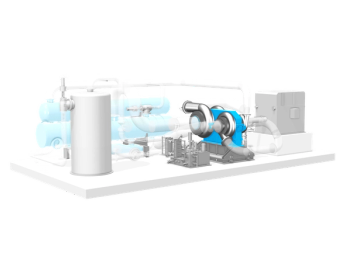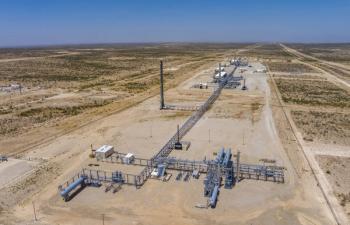
HYDRAULIC BOLT FASTENING
BEST PRACTICES FOR CRITICAL FASTENING
APPLICATION ON GAS TURBINES
By Pat McCormack
Advancements in engineering design and analysis tools have allowed many new products to be developed for maintaining and operating gas turbines. They are not only safer, but they also allow for faster and easier operation as well as cost savings. Some of these enhancements have become best practices in the industry.
One specific area of improvement is seen in critical fastening applications. A critical fastening application is any bolted joint that requires accurate and uniform bolt loading.
In the early years of turbomachinery, it was common practice to tighten a nut and bolt through thermal expansion. This process, sometimes referred to as “heat and beat,” was done by heating the stud or bolt to cause the material to expand in length. You then tighten the nut with a slug wrench and a large hammer. When the stud cools down, it contracts and creates the clamping force. Drawbacks to this method are the inconsistency in obtaining an accurate clamping force, and safety concern surrounding the use of high heat and a large hammer.
Another method used to tighten fasteners is to apply torque. It is common to see stud sizes well above one inch in diameter; a mechanical torque wrench used by a single person cannot supply enough torque.
To achieve high torque values on studs of larger size, the hydraulic torque wrench was developed. Using hydraulic pressure, it transmits far more torque than a mechanical torque wrench. This enables better bolt loading of large studs.
An alternative to stud heating and hydraulic torque wrenches that has become accepted as a best practice is hydraulic bolt tensioning. Benefits include repeatability and accuracy, as opposed to the high variance in pre-load that exists with the heat and slug wrench method, as well as the bolt torque method.
The problem of friction between threads is another area that is resolved by bolt tensioning. Friction develops in the threads of the nut and bolt, as well as when the nut is being tightened onto the flange itself. This tends to gall the material. As a result, the nut can stick and needs to be cut off.
Even if the nut does not gall and stick, friction remains a problem. The amount of friction can vary from bolt to bolt which leads to preload variation. Friction also tends to cause the bolt to wind up, which relaxes over time and loses its initial clamping force. Hydraulic bolt tensioning eliminates this issue.
For applications that do not have enough spacing between the studs for a tensioner, or there are not enough threads exposed above the nut for a standard tensioner to grip onto, a hydraulic rod tensioner can be used. The hydraulic rod tensioner was developed for applications with a very tight radial footprint.
The standard hydraulic bolt tensioner needs space to fit around the nut. The hydraulic rod tensioner, on the other hand, uses a perforated nut to allow the tensioner to use rods to push through the nut and tension the stud.
This perforated nut makes it possible to tension studs that were originally done with torque and therefore did not have the stud length to allow proper thread exposure above the nut for the standard tensioner to grip onto.
There are many different types of hydraulic bolt tensioner available on the market. Various suppliers have developed tools which can be used in different situations. As well as off-the-shelf items, specialty designs are available.
Author: Pat McCormack is Director of Business Development at Riverhawk Company.
Newsletter
Power your knowledge with the latest in turbine technology, engineering advances, and energy solutions—subscribe to Turbomachinery International today.




